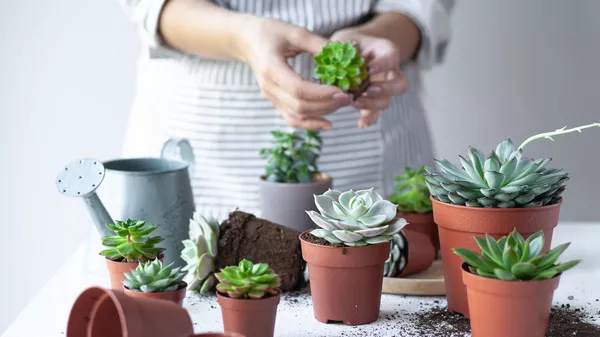Succulents, with their captivating shapes and sizes, have become beloved additions to gardens, homes, and landscapes. The diverse world of succulents encompasses a wide range of sizes, from tiny, intricate specimens to large, architectural plants.
Miniature Marvels
Succulents are renowned for their versatility, and miniature varieties add a touch of enchantment to any collection. These tiny wonders, often referred to as “mini succulents” or “baby succulents,” have a compact and delicate appearance. Examples of mini succulents include Haworthia retusa, Crassula perforata, and Sedum pachyphyllum. These diminutive succulents are ideal for small spaces, terrariums, or as charming accents in arrangements.
Small to Medium-Sized Succulents
Small to medium-sized succulents make up the majority of popular varieties available in the market. Ranging from a few inches to a foot or more in height and spread, these succulents offer a perfect balance of visual appeal and manageability. Common examples include Echeveria varieties, Aloe aristata, and various Sedum species. These succulents are well-suited for container gardens, rock gardens, and indoor arrangements, providing an array of colors, textures, and shapes.
Large and Architectural Succulents
For those seeking a bold statement in their garden or landscape, large and architectural succulents deliver a commanding presence. These specimens can reach impressive sizes, often exceeding two feet in height and spreading several feet across. Aloe vera, Agave americana, and certain varieties of Euphorbia exemplify the grandeur of large succulents. Planted as focal points or in groupings, these plants create stunning visual impact and contribute to a distinctive garden aesthetic.
Cactus Varieties
Cacti, a subset of succulents, display a wide range of sizes and shapes. From the towering saguaro cactus (Carnegiea gigantea) that can reach heights of 40 feet or more to the diminutive ball cactus (Parodia magnifica) that stays compact, cacti showcase the extremes of succulent size diversity. The iconic prickly pear cactus (Opuntia) and barrel cactus (Ferocactus) also demonstrate the spectrum of sizes within the cactus family.
Factors Influencing Succulent Size
Several factors contribute to the size of succulents, and understanding these elements can help enthusiasts anticipate the growth potential of their plants. Genetics play a crucial role, as different species and varieties have inherent size characteristics. Environmental conditions, including sunlight, temperature, and soil quality, also influence succulent size. Adequate spacing, appropriate container size, and proper watering practices contribute to the overall health and size development of succulents.
Adaptations to Environment
Succulents have evolved various size adaptations to thrive in their native environments. In arid regions, where water is scarce, succulents often adopt a compact and low-growing form to minimize water loss through transpiration. On the other hand, succulents in more temperate climates may develop larger sizes, taking advantage of favorable conditions to store water and compete for sunlight.
Container Gardening with Succulents
Container gardening allows enthusiasts to showcase succulents of various sizes in a controlled environment. Choosing appropriately sized containers based on the mature size of the succulents is crucial for their health and aesthetics. Compact varieties like hens and chicks (Sempervivum) or lithops (Living Stones) thrive in small containers, while larger containers accommodate the growth of Aloe varieties and Agave species.
Pruning and Maintenance Techniques
Pruning and maintenance practices can influence the size and shape of succulents. Regularly removing dead or decaying leaves, especially at the base of the plant, promotes a tidy appearance and encourages healthy growth. Some enthusiasts prefer to prune succulents to maintain a certain size or shape, creating sculptural arrangements or bonsai-like specimens.
Seasonal Growth Patterns
Succulents often exhibit seasonal growth patterns, with periods of active growth followed by dormancy. Understanding these cycles is essential for anticipating size changes in succulents. During active growth phases, succulents may produce new leaves, stems, or offsets, contributing to an increase in size. In dormancy, growth may slow, and certain species may shed older leaves.
Creating a Size-Appropriate Garden Design
When planning a succulent garden or landscape, incorporating a variety of sizes adds visual interest and dynamic appeal. Consider the mature sizes of succulents when designing planting arrangements to ensure a harmonious and well-balanced display. Combining miniature, small, medium, and large succulents creates a garden that evolves in scale and texture, captivating observers with its diversity.
Conclusion
The world of succulents unfolds with an incredible range of sizes, from the smallest miniatures to the grand architectural wonders. Understanding the factors influencing succulent size, embracing the diverse adaptations of different species, and incorporating size-appropriate design principles allows enthusiasts to cultivate captivating succulent collections. Whether adorning windowsills, gracing garden beds, or commanding attention in large landscapes, succulents showcase nature’s ingenuity in adapting to various environments and offer endless possibilities for plant enthusiasts and gardeners alike.


